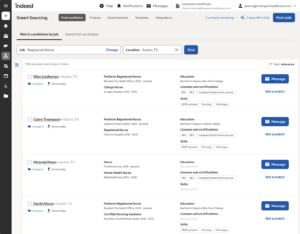Evolving the Search for the Right Candidate: Introducing Pay for Results by Indeed, the World’s Largest Job & Hiring Site
April 18, 2023
In a world where you must often choose between quality or quantity, it would be ideal to have the ability to have both simultaneously.
About ten or so years back I was at a user conference for one of the leading recruiting technology companies focused on the then-new category of video interviewing. In fact, at that time, they may have been the only leading video interviewing company, at least that was widely known. At the event I had an interesting conversation with one of the company’s founders on the primary subject of the conference – “Hiring challenges.” Shocker, I know! Ten years ago, hiring challenges was the main topic at an HR event. Like it has been the main topic of most HR events ever since, and how solving hiring challenges remains perpetually in the Top 5 list of priorities for HR and recruiting leaders to this day.
The reason I recall the conversation from a decade ago was something that a founder said to me regarding the most common complaint about most recruiting technology at that time – “Recruiting technology is failing because hiring the right candidate is like finding a needle in a haystack, and all these new tools are doing is increasing the size of the haystack.”.
Back then, as is more or less the case still now, much of the recruiting technology development and the allocation of corporate recruiting budgets were directed on getting job postings/advertisements in front of the most potential applicants as was theoretically possible, featuring these job postings more prominently, and creating engaging job ad copy (and to a lesser extent, a simpler user interface and UX), intended to generate as many applications as possible, in the shortest possible time. Success was measured in simpler terms – usually indicated by the number of impressions for the job ad, how many times was the job ad clicked (not mattering who was doing the clicking), and if you were lucky enough to have this ability for attribution – how many applications, interviews, and ultimately hires did any given job posting and advertising strategy generate.
For many roles, especially ones that were for high-volume and evergreen kinds of roles – customer service agents, retail staff, lots of hospitality and leisure positions, organizations could typically reduce the hiring puzzle into a simple mathematical formula. “X” job ad impressions will yield “Y” job ad clicks, resulting in “Z” applications. And from there, the job advertisement and distribution partners were done. Figuring out which of the “Z” applicants was the “best” one to hire was the organization’s responsibility. It is an inelegant, imprecise approach. And sometimes it is very costly. But it did work, and at times it might still work today.
But more recently organizations facing the never-ending struggle to fill open roles with the right candidates need a better, more accurate, more efficient, and more accountable model than the traditional “Let’s generate lots and lots of impressions and clicks and see where the dust settles” model. What is needed in this extended period of low overall unemployment, tight labor markets in most industries and locations, and more and more employees willing and able to switch jobs for any number of reasons, is a better, more precise approach – one that is focused more on finding the “right” candidate, not the most candidates, and one designed to provide more specific information about results and value of recruiting spending. What organizations do not need is a bigger haystack.
Frankly, organizations need to bring the concepts behind retained search and executive recruiting – mainly, the focus on identifying a shortlist of only highly qualified applicants for consideration, to all the important roles that the organization needs to fill. Imagine if for all the roles the organization had open, the chosen recruiting technology worked in a way that identified fewer, but more likely to succeed candidates, and the organization only paid for these services when applicants were considered, and not just when anyone happened to come across the job advertisement and clicked through. The retained search model is high touch, tailored, and the organization typically only pays for results. But it is expensive and not scalable.
So, what might some kind of combination of the technological advances developed for high-volume and routine hiring that generally “grew the haystack” with the elements and principles of executive recruiting built for targeted, precise approaches, and designed to surface only the best candidates for employers to review look like?
I think it would look a lot like what Indeed, the world’s largest job and hiring site has just announced, their new “Pay for Results” pricing option, which includes pay per application (PPA) and pay per started application (PPSA) options. This announcement introduces an innovation that has the potential to get organizations closer to the best of both worlds’ combination of high traffic and high visibility for job postings, along with improved candidate matching and better support for employers of all sizes.
For example, with the PPA option, employers can get quality applicants that meet their preferences and they’re only charged when they receive an application, not just a click on a job listing. With this option, they can also review the price they will be charged per completed application; set an application limit based on their budget, allowing them more control over cost-per-hire levels; automatically reject applications that don’t meet their needs by setting predetermined requirements by setting screening criteria; and using an innovative new feature, in which they have up to 72 hours to manually reject any candidate application before being charged for that application. The ability to reject a candidate prior to that application reducing the available recruiting budget (and time spent further considering less-qualified applicants) is extremely powerful, and my favorite aspect of the model.
And a Pay for Results solution aligns with employers’ preferences. A majority of employers (52%) selected pay for results as the top pricing model when compared to pay for clicks (22%) and pay a flat fee per job post (22%), according to Indeed research. Plus, with more than four in five (84%) U.S. employers saying they believe fees should be tied to obtaining quality candidates when using an online job site, Indeed’s Pay for Results pricing option meets employers where they are and re-shifts the focus from volume metrics – impressions and clicks – to where it should be – obtaining quality candidates.
These new developments from Indeed align well to help organizations overcome the most common pain points in the hiring process. According to an Indeed survey in March 2023, three of the top four most significant hiring challenges (poor quality of candidates, time to fill open jobs, and not enough applicants) are related to candidate flow and quality. With the new Pay for Results option, the powerhouse in online job listings with more than 3 million employers using the site to find and hire new employees and more than 300 million monthly unique visitors, Indeed is re-imagining and disrupting a process that has been stagnant for too long.
Thanks to Indeed for spending some time with us to review and demonstrate the new Pay for Results option. Learn more about how this solution works for employers at – https://www.indeed.com/lead/how-paying-for-results-can-maximize-your-hiring-budget .
How we can help
Led by Trish Steed and Steve Boese, H3 HR Advisors harnesses over 40 years of experience to delivery HCM insights and guidance to global organizations.
H3 HR Advisory services
By leveraging technology, analytics, and our deep industry knowledge we can help you to reposition your workforce and ensure that you have the right people with the right capabilities in the right roles to positively impact the growth of your business.
HR Happy Hour Podcast Network
Created in 2009, The HR Happy Hour Show is hosted by Steve Boese and Trish Steed and is the longest continuously running internet radio show and podcast on Human Resources, HR Technology, Talent Practices, Workplace and Leadership topics.
H3 HR Speaking Services
We work closely with every client to customize your content - keynotes, webinars, research, infographics, and buyer’s guides - to inspire, educate and inform the audience enabling you to reset and realign your organization for a talent-led breakthrough.
Get in touch
Talk to us today and find out how we can help you and your organization leverage HCM technology to attract, onboard, retain and manage top talent.




